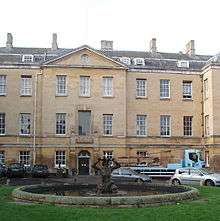Radcliffe Infirmary
The Radcliffe Infirmary was a hospital in central north Oxford, England, located at the southern end of Woodstock Road on the western side, backing onto Walton Street.
| Radcliffe Infirmary | |
|---|---|
| Oxford Radcliffe Hospitals NHS Trust | |
 | |

| |
 Shown in Oxfordshire | |
| Geography | |
| Location | Oxford, Oxfordshire, England, United Kingdom |
| Coordinates | 51°45′37″N 1°15′43″W |
| Organisation | |
| Care system | Public NHS |
| Type | General |
| Affiliated university | University of Oxford |
| Services | |
| Emergency department | No Accident & Emergency |
| Beds | 275 |
| History | |
| Opened | 1770 |
| Closed | 2007 |
| Links | |
| Website | oxfordradcliffe |
| Lists | Hospitals in England |
History
The initial proposals to build a hospital in Oxford were put forward at a meeting of the Radcliffe Trustees, who were administering John Radcliffe's estate valued at £4,000, in 1758. The facility was constructed on land given by Thomas Rowney, one of the two members of parliament for Oxford. The foundation stone was laid on 27 August 1761 and the new facility was officially opened on 18 October 1770.[1]
A fountain of the Greek god Triton was placed in front of the main infirmary building in 1858[2] and the Oxford Eye Hospital was established on the site in 1886.[3]
During the First World War, the hospital was converted for military use as the Third Southern General Hospital. Officers were treated in Somerville College, which was also converted, and other ranks were treated in the infirmary.[4]
A number of pioneering moments in medical history occurred at the hospital. Penicillin was first tested on patients on 27 January 1941[5] and the Nuffield Laboratory of Ophthalmology was founded on the site in 1942.[3]
The entrance of the hospital was seen in the ITV television series Inspector Morse in 1991.[6] The first Utah Array (later known as the BrainGate) implantation in a human (Kevin Warwick) took place on 14 March 2002.[7]
After services had been transferred to purpose-built buildings at the John Radcliffe and Churchill Hospitals in nearby Headington, the infirmary closed for medical use in 2007.[8] Following refurbishment, the infirmary building was re-opened in October 2012 for use by the Faculty of Philosophy and both the Philosophy and Theology libraries of the University of Oxford.[2] The site, which is now known as the Radcliffe Observatory Quarter, also became home to the Blavatnik School of Government in 2012.[2]
References
- "The Radcliffe Infirmary". Oxford History. Retrieved 14 October 2018.
- "Radcliffe Observatory Quarter (ROQ)". University of Oxford. Retrieved 24 August 2015.
- A brief history of the Nuffield Laboratory of Ophthalmology Archived 2 October 2013 at the Wayback Machine
- "Oxford and the First World War: Third Southern General Hospital". Oxford History. Retrieved 14 October 2018.
- "Making Penicillin Possible: Norman Heatley Remembers". ScienceWatch. Thomson Scientific. 2007. Archived from the original on 21 February 2007. Retrieved 13 February 2007.
- "Inspector Morse (TV Series); Second Time Around (1991)". IMDB. Retrieved 14 October 2018.
- "SCI/TECH | Cyborg study draws fire". BBC News. 22 March 2002. Retrieved 24 August 2015.
- Oxford University takes over Radcliffe Infirmary site Archived 22 July 2009 at the Wayback Machine
Further reading
- Gibson, Alexander (1926). The Radcliffe Infirmary. Oxford University Press.
- Moss, Andrew (2007). The Radcliffe Infirmary. History Press. ISBN 978-0752442488.
- Robb-Smith, A.H.T. (1970). A Short History of the Radcliffe Infirmary. Church Army Press/United Oxford Hospitals. ISBN 978-0950167404.
- Selby-Green, Jenny (1991). History of the Radcliffe Infirmary. Image Publications. ISBN 978-1873241059.
External links
| Wikimedia Commons has media related to Radcliffe Infirmary. |